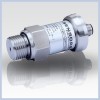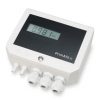Pressure sensors featuring RS485 serial output for robust digital communication in multi-drop networks. Ideal for PLC/SCADA integration & industrial automation.
RS485 serial interface pressure sensors offer a robust method for digital pressure measurement, specifically designed for integration into distributed monitoring and control systems. These sensors leverage the noise immunity and long-distance capabilities of the RS485 standard, allowing multiple devices, each with a unique address, to communicate reliably over a shared multi-drop network bus. This simplifies system architecture and wiring, making them ideal for engineers designing complex industrial automation, process control, or environmental monitoring applications requiring data collection from numerous pressure points connected to a central PLC, HMI, or computer system.
 Modbus RTU pressure monitoring in data center chilled water cooling loops - Networkable pressure sensors provide essential data for maintaining optimal performance and preventing downtime in mission-critical data center chilled water systems.
Modbus RTU pressure monitoring in data center chilled water cooling loops - Networkable pressure sensors provide essential data for maintaining optimal performance and preventing downtime in mission-critical data center chilled water systems. Airflow and chamber pressure measurement for a portable modbus data acquisition trolley - Differential pressure sensor and a analogue signal to Modbus RTU RS-485 converter provided a flexible solution for measuring bidirectional pressures from a test chamber and an orifice plate on a mobile test rig.
Airflow and chamber pressure measurement for a portable modbus data acquisition trolley - Differential pressure sensor and a analogue signal to Modbus RTU RS-485 converter provided a flexible solution for measuring bidirectional pressures from a test chamber and an orifice plate on a mobile test rig.
 DCT 531 Modbus RTU RS485 Pressure Sensor
DCT 531 Modbus RTU RS485 Pressure Sensor DPT100 Modbus RTU RS485 Differential Pressure Sensor
DPT100 Modbus RTU RS485 Differential Pressure Sensor PrimAtü 10 Low Cost Low Range Differential Air Pressure Transducer
PrimAtü 10 Low Cost Low Range Differential Air Pressure Transducer DCT531P RS485 Modbus RTU Flush Pressure Sensor
DCT531P RS485 Modbus RTU Flush Pressure Sensor
- Power generation OEM engine oil pressure sensor with 75bar abs range and RS485 - Robust RS485 absolute pressure sensor for OEM engine oil monitoring in power generation. 0-75 bar range, G1/4 male process connection, and M12 electrical connector. 9-32V DC supply.
Find out more about RS485 Serial Interface Pressure Sensors to determine which product options and capabilities will best meet your application requirements.
RS485 output pressure sensors provide a robust digital communication solution ideal for integrating multiple pressure measurement points into larger control or monitoring systems. Utilizing the RS485 serial interface standard, these sensors transmit pressure readings digitally, minimizing signal degradation and electrical noise interference often encountered in industrial environments, especially over extended cable distances far exceeding the limitations of typical voltage or current loop analog outputs.
A key advantage of employing RS485 pressure sensors lies in their multi-drop capability. Each sensor can be assigned a unique device address on the network, allowing a single master device, such as a PLC, HMI, or computer, to communicate with numerous sensors connected along the same two-wire or four-wire bus. This significantly reduces wiring complexity and installation costs compared to point-to-point analog sensor installations, where each sensor requires a dedicated cable run back to the data acquisition unit.
The implementation of unique device addressing enables targeted polling, where the master controller can request data specifically from an individual pressure sensor within the network. This facilitates structured data acquisition from distinct locations, such as monitoring pressures across various stages of a manufacturing process, different tanks in a storage facility, or multiple points within a complex hydraulic system. The digital nature of the data transmission ensures high fidelity readings are delivered to the control system.
Integration with host systems is typically straightforward, leveraging standard RS485 ports commonly found on industrial PLCs, RTUs (Remote Terminal Units), and dedicated data loggers. For systems lacking native RS485 support, readily available converters (e.g., RS485-to-USB, RS485-to-Ethernet) provide seamless connectivity. Often, these sensors communicate using established protocols layered upon RS485, such as Modbus RTU, which simplifies configuration and interoperability within existing SCADA or building management systems.
Common applications for RS485 pressure sensors include monitoring pipelines, managing HVAC systems in large buildings, controlling industrial automation processes, and gathering data in distributed environmental monitoring networks. Their suitability for networking makes them particularly valuable in test rigs requiring synchronized data from multiple pressure points or in mobile machinery where wiring needs to be minimized. Design engineers and system integrators appreciate the scalability and robustness offered by connecting pressure sensors via an RS485 serial bus.
When specifying these sensors, engineers must consider parameters beyond pressure range and accuracy, including the required communication protocol (e.g., Modbus RTU, ASCII), baud rate, data bit format, and network termination requirements to ensure reliable communication across the entire sensor network. Proper network topology planning, often a daisy-chain configuration, and the use of appropriate termination resistors at the bus ends are crucial for maintaining signal integrity.
Product Help
Comparing digital and analogue outputs for precision pressure measurement
My pressure transmitter is equipped with both a 4-20mA analog output and an RS485 digital interface. For a high-accuracy application like a pressure decay leak test, which signal provides better performance?
For high-precision applications where measurement resolution, stability, and data integrity are paramount, the RS485 digital output is the superior choice.
Here are the key advantages of using the digital signal for a sensitive task like a pressure decay leak test:
- Maximum Resolution: The digital signal transmits the pressure value directly from the sensor’s internal high-resolution processor, with some sensors achieving a digital resolution of 0.0005% of its full scale. This fine resolution is transmitted without any degradation, which is essential for detecting the very small pressure drops characteristic of a slow leak.
- No Conversion Errors: The digital output is the direct, compensated value from the piezoresistive sensing element. It completely bypasses the Digital-to-Analog Converter (DAC) required to create the 4-20mA signal. This eliminates any additional errors or non-linearities the DAC might introduce, which can be up to ±0.05% FS.
- High Noise Immunity: As a differential communication protocol, RS485 is inherently robust against electromagnetic interference (EMI) and ground loop problems that can corrupt a 4-20mA signal in an industrial setting. This results in a cleaner, more stable reading.
- Auxiliary Data: The digital interface, often utilizing the Modbus RTU protocol, allows you to access more than just the pressure reading. You can also read the sensor’s internal temperature, access its serial number for asset tracking, and receive diagnostic information, all over the same pair of wires.
The 4-20mA analog output remains a practical and reliable choice for interfacing with standard PLCs, panel meters, and legacy control systems that require a simple, industry-standard signal for general process monitoring and control. However, for data logging and analysis that demands the highest fidelity, the digital RS485 interface is unmatched.
